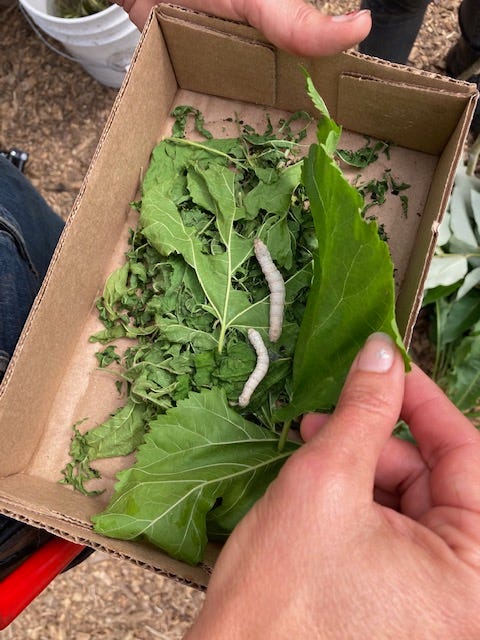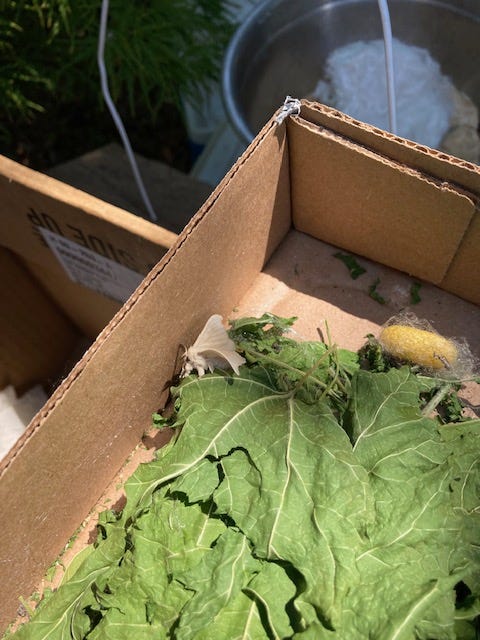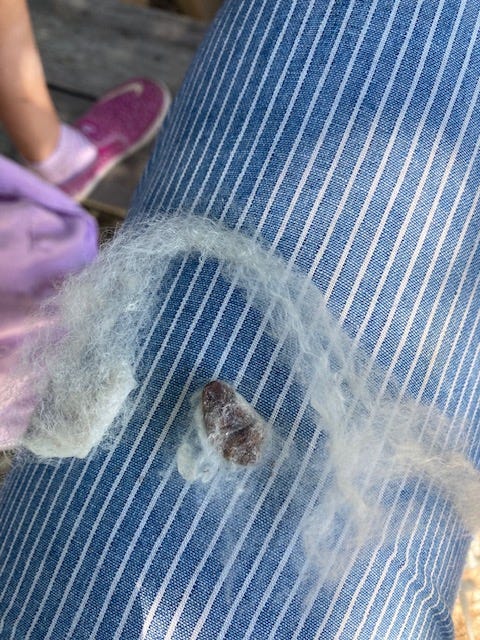On Silks and Cocoons
Have you ever seen a silkworm or a bombyx moth, or felt raw silk fiber?
This year I’ve joined Rewild Portland for The Weaver’s Wheel, a nine month-long group focused on fiber, craft, and land-tending. It’s been so much fun already and I’m looking forward to many more weeks of learning. Last week in between gardening, weeding, and harvesting dye flowers, we got to play with some silkworm cocoons!
I’ve stitched, sewn, and worn silk before, but have never touched a cocoon or seen a silkworm moth. They. are. so. cute!


The two photos here are from our Rewild teacher’s personal worms she’s raised this year from eggs. A silkworm larvae hatches from an egg and takes about 30 days to mature, eating every mulberry leaf in sight on it’s way. When they’re stuffed and big they spin their cocoon into a perfect oval shape made from one continuous filament. That silk filament, stretched out, can be up to a mile long! It’s that single unbroken monofilament that, when spun and woven, makes such a smooth cloth.
Here’s what’s wild: sericulture, or the practice of raising silkworms, is over 7,000 years old! It was so important that the biggest trade route in history was named after it. Chinese folklore tells the tale of Leizu, the Queen of Textiles who spreads the knowledge of silk processing. Korean folklore offers the tale of a princess that is turned into a silkworm goddess (her cocoon involves a horse skin, which is an odd addition that only an ancient folktale can get away with).
I got to try pulling the filaments out of the cocoon and hand twisting/spinning it. It’s a rough attempt (don’t judge me, it’s my very first try at spinning anything at all!), but it was so fun to gently pull and twist the delicate filaments until I got to the surprise worm inside. In places with a long history of sericulture, folks would eat the worms, which makes sense as they wouldn’t want it to go to waste.


For a fabric that doesn’t involve dead worms, you can let the moth hatch, live it’s short but natural life, and still create fiber from the cocoon. This is silk noil, or raw silk/ peace silk: the strands are in shorter pieces so it’s not as smooth and lustrous, but still drapes like silk, is just as strong, and is even easier to care for.
I’ve never spun any fiber before, and I’m looking forward to learning more! I’ll get the chance to work with a drop spindle later in the year, and my thoughtful husband recently found me a used spinning wheel that’s patiently waiting some attention. (I did not ask for this, but he said “You would have eventually.” He’s right, of course.)
More reading:
Golden Spider Silk Cape from the V&A: This is STUNNING! Spider silk is even stronger than silkworm silk, but of course much harder to harvest. Maybe someday scientists will create a hybrid silkworm/spider that combines the strength, beauty, and ease of both into one magical thread. Some are trying other techniques already.
Last Chance Textiles just wrote a great blog post about silk noil, which is in many of their bandanas. I have two myself and I love them!
Here’s a longer version of the Korean Silkworm Goddess Tale.
UNESCO recognition: China has had a huge influence on the world with their long history with silk and silkworms. In 2009 their Sericulture and Silk Craftmanship was inscribed on the UNSECO’s Representative List of the Intangible Cultural Heritage of Humanity.
You want to try? You can order cocoons to spin yourself, or even eggs to raise! It’s that easy! Maybe? Let me know if you do!





